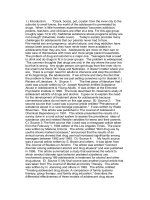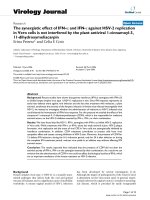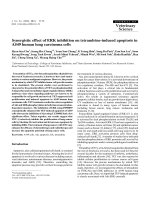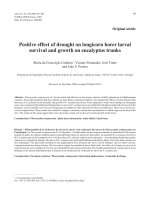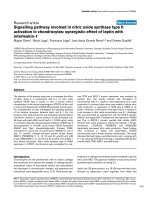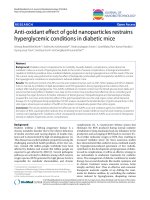Synergistic effect of two foreign metal ions on shape selective synthesis of gold nanocrystals
Bạn đang xem bản rút gọn của tài liệu. Xem và tải ngay bản đầy đủ của tài liệu tại đây (2.03 MB, 60 trang )
SYNERGISTIC EFFECT OF TWO FOREIGN METAL IONS
ON SHAPE-SELECTIVE SYNTHESIS OF GOLD
NANOCRYSTALS
TRAN TRONG TOAN
NATIONAL UNIVERSITY OF SINGAPORE
2011
SYNERGISTIC EFFECT OF TWO FOREIGN METAL IONS
ON SHAPE-SELECTIVE SYNTHESIS OF
GOLD NANOCRYSTALS
TRAN TRONG TOAN
(B.Sc. (Hons.), University of Science Ho Chi Minh City)
A THESIS SUBMITTED
FOR THE DEGREE OF MASTER OF ENGINEERING
DEPARTMENT OF CHEMICAL AND BIOMOLECULAR ENGINEERING
NATIONAL UNIVERSITY OF SINGAPORE
2011
ACKNOWLEDGEMENTS
First of all, I would like to express my deep gratitude towards the following people
who have helped me complete the thesis.
A special thank to my research supervisor, Assistant Professor Lu Xianmao, for
offering an opportunity to me to be a part of his research group. I want to thank him
for his invaluable support and all the guidance throughout the course of study. I would
also like to thank my thesis examiners, Professor Zeng Hua Chun and Assistant
Professor Saif A. Khan for their advice, guidance and encouragement throughout my
MEng study.
All the professional officers and lab technologists, Mr. Chia Phai Ann, Dr. Yuan Ze
Liang, Ms. Lee Chai Keng, Ms. Li Xiang, Dr. Yang Liming, Ms. Li Fengmei, and
other staffs who have unconditionally helped me in many administrative works as
well as experiments and have willingly shared their knowledge and expertise to
further enhance my studying process.
My colleagues, Dr. Sun Zhipeng, Ms. Zhang Weiqing, Mr. Shaik Firdoz, and all the
final year students for all their kind supports they provided.
Finally, I want to specially thank my parents who have given me all what they have
for their unconditional support and their love. I also want to thank my girlfriend for
her non-stop support during my study.
i
Table of Contents
Acknowledgement .................................................................................................. i
Table of Contents ................................................................................................. ii
Summary.............................................................................................................. iv
Nomenclature ....................................................................................................... vi
List of Figures..................................................................................................... vii
List of Tables ....................................................................................................... ix
Chapter 1. Introduction........................................................................................ 1
1.1. Background ................................................................................................. 1
1.2. Research objectives ..................................................................................... 2
1.3. References ....................................................................................................3
Chapter 2. Literature Review .............................................................................. 4
2.1. Shape-controlled synthesis of noble metal nanocrystals............................. 4
2.1.1. Nucleation and growth of metal nanocrystals ..................................... 4
2.1.2. Chemical methods for synthesis of metal nanocrystals
with controlled shapes ................................................................................... 6
2.1.2.1. Seeded-growth route.................................................................. 6
2.1.2.2. Hydrothermal route.................................................................... 8
2.1.2.3. Electrochemical route ................................................................ 8
2.1.2.4. Photochemical route .................................................................. 9
2.1.2.5. Polyol route.............................................................................. 10
ii
2.2. Synthesis and catalytic properties of metal nanocrystals
with high-index facets ..................................................................................... 12
2.3. References ..................................................................................................14
Chapter 3. Shape-controlled Synthesis of Au Nanocrystals
with High-index Facets .......................................................................................17
3.1. Shape-selective growth of polyhedral gold nanocrystals
with high-index facets .......................................................................................17
3.1.1. Introduction ..................................................................................... 17
3.1.2. Experimental Section ...................................................................... 19
3.1.3. Results & discussion ....................................................................... 22
3.1.4. Conclusion....................................................................................... 39
3.2. References ..................................................................................................41
Chapter 4. Conclusions and Recommendations for Future Work................. 43
4.1. Conclusions ............................................................................................... 43
4.2. Recommendations for Future work........................................................... 44
4.3. References ................................................................................................. 48
iii
Summary
Shape-controlled synthesis of metal nanocrystals has been widely investigated
for the last several decades because of its ability to tailor the morphology of metal
nanocrystals, and therefore, their physical and chemical properties. These properties,
which greatly differ from their bulk counterparts, are highly dependent on the size and
the shape of the nanocrystals. Metal nanocrystals with many shapes such as cubes,
octahedra, cubotahedra, icosahedra, plates, rods, and wires in various sizes have been
synthesized. However, these nanocrystals are mainly enclosed by low Miller-index
facets (i.e. {111}, {100}, and {110}). Recently, much focus has been given to metal
nanocrystals with high-index facets due to their superior catalytic properties to those
bounded by low-index facets. The metal nanocrystals with high-index facets are,
however, difficult to be prepared due to the fact that high-index facets are not as
stable as those low-index ones during the synthetic period.
In this work, we present the facile PDDA-mediated polyol route for synthesis
of a series of novel Au nanocrystals, namely, truncated octahedra bounded by both
{111} and {310} facets, truncated ditetragonal prisms exclusively enclosed by {310}
facets, and bipyramids with exposed {117} facets by simply varying the ratio of Ag
and Pd ions. The synergistic effect of Ag and Pd ions on the formation of the novel
Au nanocrystals was studied. In our experimental conditions, the underpotential
deposition (UPD) of Ag on Au surface was believed to inhibit the growth along
<110> directions, therefore lead to the formation of {110} facets on Au nanocrystals.
Palladium ions could, on the other hand, also take part in the deposition on Au surface
and stabilize {100} facets. Together, Ag and Pd ions enabled the growth of {310}
facets on the Au nanocrystals as {310} facets are composed of {110} and {100}
iv
subfacets. Since the Au nanocrystals obtained in this report possess high-index facets,
they are expected to be promising candidates for many catalytic applications.
v
Nomenclature
CTAB
Cetyltrimethylammonium bromide
CTAC
Cetyltrimethylammonium chloride
EDX
Energy dispersive X-ray spectroscopy
EG
Ethylene glycol
FESEM
Field-emission scanning electron microscopy
ICP-MS
Inductive coupling plasma mass spectrometry
PDDA
Poly(diallyldimethylamonium chloride)
PEG
Polyethyleneglycol
PVP
Polyvinylpyrrolidone
SAED
Selected area electron diffraction
SEM
Scanning electron microscopy
TEM
Transmission electron microscopy
vi
List of Figures
Figure 3.1. (A) Low and (B) high magnification SEM images of Au truncated
ditetragonal prisms showing well-defined structures with sharp edges and apexes. (C)
HRSEM of a group of Au truncated ditetragonal prisms. (D) TEM images of Au
truncated ditetragonal prisms showing its cross-section. (E) High magnification of a
truncated ditetragonal prism (inset) exhibiting (200) d-spacing of fcc Au. (F) The
schematic drawings at different views of an Au nanoprism ....................................... 23
Figure 3.2. Determination of facets of Au truncated ditetragonal prisms from
different views (A) top view (cross-section) and (B) side view. The result indicates
that Au truncated ditetragonal prisms are bound by 12 {310} facets. Note that image
(A) and (B) were taken from different truncated ditetragonal prisms. (C), (D)
Schematic drawing of truncated ditetragonal prisms with their theoretical angles. (E)
Atomic model of Au (310) facet including (110) and (100) subfacets....................... 24
Figure 3.3. (A), (B), (C) and (D) Schematic models for Au truncated ditetragonal
prisms at different views illustrating for (E), (F), (G) and (H) the corresponding TEM
images. (I), (J), (K) and (L) the ED patterns that consistently show all [310] zone
axes. Note that the SAED patterns were taken from different Au nanoprisms .......... 25
Figure 3.4. Schematic models for other configurations of Au truncated ditetragonal
prisms which differ from the Au nanoprisms in Figure 3.1. (A) one sloping face pair
(at one end) rotated 90° around the principle axis, (B) one vertical half rotated 90° so
that two side faces become two new sloping faces at two ends, and (C) one sloping
face pair (at one end) rotated 90° around the principle axis and one vertical half
rotated 90° so that two side faces become two new sloping faces at two ends (i.e.
combining (A) and (B)) .............................................................................................. 25
Figure 3.5. (A) Low and (B) high magnification SEM images of Au bipyramids. Inset
of Figure 3B clearly shows a pentagonal cross-section of an exceptionally big
bipyramid. Inset scale bar is 100 nm. (C) TEM image of Au bipyramids. (D) HRTEM
image of a bipyramid (inset) describes the (111) d-spacing. Inset scale bar is 20 nm.
(E) The corresponding ED pattern showing the superposition of [110] and [111] zones
of fcc structure. (F) Schematic drawing of a bipyramid ............................................. 27
Figure 3.6. (A) TEM image of an Au nanobipyramid with defined width base (W,
yellow line) and height of half (Hhf, red line). (B) Model of half of pentagonal
bipyramid and formula that exhibits the relationship between morphological
measurements (i.e. W and Hhf) and Miller index of the bipyramidal facets. By
measuring few tens of Au bipyramids in TEM images, we could determine the
average Hhf/W ratio of 2.18 which means that the Au bipyramids obtained in this
work enclosed by the high-index {117} facets........................................................... 27
Figure 3.7. (A) Low magnification SEM image of Au truncated octahedra. Inset
shows schematic model of a truncated octahedron that exposes both {111} and {310}
facets. (B) High magnification SEM image of truncated octahedra with a superposed
drawing frame on single truncated octahedra shows the consistency with the
schematic model. (C) TEM image of Au truncated octahedra with the inset showing
vii
(200) d-spacing of Au fcc. (D), (E) ED patterns of Au truncated octahedra clearly
show [310] and [111] zone axes. (F) Schematic drawing showing the morphological
relationship between an octahedron and a truncated octahedron................................ 28
Figure 3.8. EDX analyses of Au nanostructures: (A) truncated ditetragonal prisms,
(B) bipyramids and (C) truncated octahedra............................................................... 30
Figure 3.9. XPS analyses of Au nanostructures: (A) truncated ditetragonal prisms,
(B) bipyramids and (C) truncated octahedra............................................................... 31
Figure 3.10. XRD patterns of Au nanostructures: (A) truncated ditetragonal prisms,
(B) bipyramids and (C) truncated octahedra............................................................... 33
Figure 3.11. UV-vis spectra of Au truncated ditetragonal prisms, bipyramids and
truncated octahedra ..................................................................................................... 34
Figure 3.12. Au nanostructures synthesized at different temperature: (A, C and E) at
140 °C and (B, D and F) at 170 °C. The procedures were similar to those used for the
syntheses of Au truncated ditetragonal prisms, bipyramids and truncated octahedra
except that no NaCl was used for the truncated ditetragonal prism synthesis. (A, B)
Truncated ditetragonal prisms with the longest lengths of 52 and 30 nm, (C, D)
bipyramids with lengths of 53 and 40 nm and (E, F) truncated octahedra with
diameters of 75 and 32 nm.......................................................................................... 35
Figure 3.13. Au nanostructures obtained without the addition of Pd2+. The
concentration of AuCl4- in these experiments was kept the same as previously. The
concentrations of Ag+ are as follows: (A) 0.024 mM; (B) 0.096 mM; (C) 0.476 mM
..................................................................................................................................... 37
Figure 3.14. Au nanoparticles synthesized without the addition of Ag+. (A) [Pd2+] = 0
mM, 195 °C, 30 min; (B) [Pd2+] = 0.06 mM, 120 °C, 12 h; (C) [Pd2+] = 0.12 mM, 120
°C, 12 h ....................................................................................................................... 39
viii
vii
List of Tables
Table 3.1. Atomic composition based on EDX, ICP-MS and XPS of Au truncated
ditetragonal prisms, bipyramids and {310} truncated octahedra.................................32
ix
Chapter 1. Introduction
1.1. Background
Noble metal nanoparticles are excellent catalysts for many chemical
transformations due to their much higher surface-to-volume ratio than the bulk
materials.1-3 Since the catalytic properties of metal nanoparticles are highly dependent
on the morphology,3-8 control of their shape and size holds great promise for the
preparation of catalysts with improved performance.3,9,10
Noble metal nanocrystals with high-index facets are known to provide high
catalytic activities because of their high density of low-coordinated surface atoms that
can serve as active sites for breaking chemical bonds.11,12 Therefore, synthesis of
metal nanocrystals with high-index facets has been of much interest to numerous
investigators during the past decade. However, it still remains challenging to fabricate
such nanocrystals because of their high surface energy and thus low stability.
Recently, metal nanocrystals bounded by high-index facets such as Pt and Pd
tetrahexahedral (THH) nanocrystals have been synthesized using electrochemical
method.13,14 The Pt and Pd THH particles have exhibited 2-6 times higher catalytic
activity per unit surface area than the commercial catalysts toward ethanol
electrooxidation. These works, therefore, shed new light to the synthesis of metal
nanocrystals enclosed by high-index facets for catalysis, although the electrochemical
approach is limited to small-scale production. Wet chemical synthesis is promising
for large-scale preparation of nanocrystals.15,16 However, the current wet chemical
routes still lack the ability to simultaneously control over the shape and size of metal
nanocrystals bounded by high-index facets.
1
1.2. Research objectives
The synthesis of metal nanocrystals with high-index facets using wet chemical
methods is currently of intensive focus. Moreover, the study of catalytic properties of
metal nanocrystals bounded by high-index facets as well as the use of these
nanocrystals as the building blocks for more complex heterometallic nanostructures
are promising topics in nanoscience and nanotechnology. So far, by using a modified
polyol process in combined with the use of Ag(I) and Pd(II) as foreign ions, we have
successfully synthesized Au nanocrystals with exposed high-index facets including
truncated octahedra enclosed by both {111} and {310} facets, truncated ditetragonal
prisms bounded by twelve {310} facets, and bipyramids with {117} facets.
2
1.3. References
(1)
Li, Y.; Hong, X. M.; Collard, D. M.; El-Sayed, M. A. Org. Lett. 2000, 2, 2385.
(2)
Kim, S. W.; Kim, M.; Lee, W. Y.; Hyeon, T. J. Am. Chem. Soc.
2002, 124, 7642.
(3)
Wang, D. S.; Xie, T.; Li, Y. D. Nano Res. 2009, 2, 30.
(4)
Narayanan, R.; El-Sayed, M. A. Nano Lett. 2004, 4, 1343.
(5)
Narayanan, R.; El-Sayed, M. A. J. Phys. Chem. B 2005, 109, 12663.
(6)
Tao, A. R.; Habas, S.; Yang, P. Small 2008, 4, 310.
(7)
Xu, R.; Wang, D. S.; Zhang, J. T.; Li, Y. D. Chemistry Asian J. 2006, 1, 888.
(8)
Schmidt, E.; Vargas, A.; Mallat, T.; Baiker, A. J. Am. Chem. Soc. 2009, 131,
12358.
(9)
Xia, Y. N.; Xiong, Y.; Lim, B.; Skrabalak, S. E. Angew. Chem. Int. Ed. 2009,
48, 60.
(10)
Burda, C.; Chen, X. B.; Narayanan, R.; El-Sayed, M. A. Chem. Rev. 2005,
105, 1025.
(11)
Somorjai, G. A.; Blakely, D. W. Nature 1975, 258, 580.
(12)
Somorjai, G. A. Science 1985, 227, 902.
(13)
Tian, N.; Zhou, Z.-Y.; Sun, S.-G.; Ding, Y.; Wang, Z. L. Science 2007, 316,
732.
(14)
Tian, N.; Zhou, Z.-Y.; Yu, N.-F.; Wang, L.-Y.; Sun, S.-G. J. Am. Chem. Soc.
2010, 132, 7580.
(15)
Ma, Y.; Kuang, Q.; Jiang, Z.; Xie, Z.; Huang, R.; Zheng, L. Angew. Chem. Int.
Ed. 2008, 47, 8901.
(16)
Ming, T.; Feng, W.; Tang, Q.; Wang, F.; Sun, L.; Wang, J.; Yan, C. J. Am.
Chem. Soc. 2009, 131, 16350.
3
Chapter 2. Literature Review
2.1. Shape-control synthesis of noble metal nanocrystals
In order to control the shape and size of metal nanocrystals, one should know
how they are created and grown. From these understandings, one can basically choose
the appropriate synthetic method to selectively fabricate the desired shapes and sizes
of the metal nanocrystals. Thus, in this part, a brief discussion of the growth
mechanism of metal nanocrystals is introduced, followed by a review of various
chemical methods in shape-controlled synthesis of noble metal nanocrystals.
2.1.1. Nucleation and growth of metal nanocrystals
Chemical synthesis of nanoparticles involves either decomposition or reduction
of metal precursors.
For the decomposition route, nucleation stage is considered to follow the LaMer
diagram.1 Briefly, under suitable conditions the number of metal atoms increases with
time. As this concentration reaches supersaturation stage, the nucleation events start
to happen and precursor concentration drops accordingly. In case the atomic
concentration sinking too fast, no more homogeneous nucleation can occur, leading to
uniform size of the nuclei. With the non-stop addition of new metal atoms from the
bulk solution, the nuclei develop into nanocrystals and then cease to grow when the
equilibrium state is achieved between surface atoms and the atoms remaining in the
bulk solution.2
For the reduction route, the chemical precursors are to be reduced into atoms
before these atoms agglomerate with each other to form nuclei. Afterwards, these
nuclei keep growing in size through an autocatalytic process in which the newly born
4
atoms are continuously added onto the nuclei surfaces. Finally, these nuclei grow into
nanoparticles with much bigger sizes.2
During the growth from nuclei to nanocrystals, firstly, the nuclei grow and form
seed with the presence of facets due to the fact that thermal fluctuation is no longer
energetically sufficient to randomly change the morphology of the nuclei.2 The seeds,
at this stage, must take their own configurations either single-crystals, singly twinned
or multiply twinned structures. This stage can be considered as the most important
stage to define the final shape and structure of the resultant nanocrystals because the
configuration (i.e., single-crystalline, singly twinned or multiply twinned) taken by
the seed will also be the resultant configuration for the nanocrystals later on.
With single-crystalline seeds, the final nanocrystals would accept either
polyhedral or anisotropic structures. For polyhedral shapes, the seeds will take the
octahedral forms if R (ratio of growth rate along <100> to <111> directions.) is equal
to 1.73, cuboctahedral forms if R = 0.87 and cubic shapes if R = 0.58. Therefore, for
fcc nanocrystals, R value is a very important parameter to control if one expects to
exclusively produce one of the three polyhedrons. For anisotropic structures which
are the consequences of symmetry breaking effect, octagonal rod and bar can be
formed from cuboctahedron and cube, respectively, through the so-called surface
passivation.
With singly twinned seeds, the resultant nanocrystals could be either right
bipyramids or beams which are favorable shapes for nanocrystals with one twinned
plane located in the middle.
With multiply twinned (usually penta-twinned) seeds, three possible shapes have
been obtained, namely, decahedron, icosahedron and pentagonal rod. While
5
decahedron and icosahedron are composed of certain numbers of identical tetrahedra
subunits, pentagonal rod is formed by five elongated tetrahedra which share one
common edge.
Finally, with plate-like seeds having stacking faults, the resultant nanocrystals
will take the hexagonal or triangular plate shape.
2.1.2. Chemical methods for synthesis of metal nanocrystals with controlled
shapes
Current wet chemical methods for shape-controlled synthesis of metal
nanocrystals
mainly
include
seeded-growth,
hydrothermal,
electrochemical,
photochemical and polyol routes. Each method has its advantages and disadvantages
and can find applications in different areas.
2.1.2.1. Seeded-growth route
Seeded-growth method is a two- or multi-stage chemical process. At the first
stage, metal precursor is quickly reduced in aqueous solution with high surfactant
concentration by using a strong reducing agent (usually NaBH4). Under such a
concentrated-surfactant condition, metal seeds formed are very small, about 3-5 nm in
diameter.3-5 These preformed-seeds are subsequently added into the so-called “growth
solution” that contains suitable concentrations of the metal precursor, surfactant and a
mild reducing agent. The ability to control the shape and size of the resultant
nanocrystals relies on the rational input ratio between seeds, precursor, and surfactant.
This method has been widely used to control the shape and size of metal nanocrystals
as it can separate the nucleation stage from the growth stage.
6
Seeded-growth method has been reported by the Murphy’s group in the synthesis
of spherical and rod-like Au nanoparticles.3 This method has been employed to
synthesize various shapes of Au nanoparticles including cubes, octahedra, rods, and
multipods.4
Seeded-growth has also been adopted and modified by other groups to further
improve its ability to produce various shapes of gold and other noble metal
nanoparticles with uniform sizes. For example, El-Sayed and co-workers modified the
synthesis of Au nanorods with the use of CTAB-capped seeds and the addition of
trace AgNO3 that could boost the yield of single-crystalline Au nanorods up to 99%.6
Guyot-Sionnest et al. reported the growth of either Au nanorods or bipyramids by
using single-crystalline or multiply twinned seeds.5 Recently, Huang et al. presented a
facile seed-mediated growth with the use of Cu UPD on Pd nanocrystals to synthesize
monodisperse, long Pd nanorods.7 Very recently, Xu and co-workers performed the
growth of uniform Pd polyhedral nanoparticles, namely, cubes, octahedra, rhombic
cuboctahedra and their intermediate forms by controlling KI concentration and
reaction temperature.8
Although seeded-growth has been considered as one of the most powerful
methods for synthesizing metal nanoparticles, it strictly requires the very accurate
conditions for making seeds such as pH value and concentration of the strong
reducing agent. Additionally, metal nanoparticles synthesized by this method are
usually very difficult to be stored for a long time.
67
8
2.1.2.2. Hydrothermal route
Hydrothermal method involves a process in which metal precursor, surfactant and
solvent (normally water) are first mixed together at room temperature. The whole
reaction solution is then transferred into a Teflon vessel that is closely sealed by the
external metal shell. The system is subsequently heated up to a high temperature
which is usually higher than the boiling point of the solvent in the system. The
nucleation and growth stage are to be one after another to finally produce the metal
nanocrystals. The hydrothermal pathway has attracted much attention due to its
simple one-step reaction but can provide a wide range of shapes of metal
nanocrystals. For example, Quian et al. reported the procedure for synthesis of Ag
nanowires by using a simple hydrothermal method.9 Dong et al. used PDDA-mediated
hydrothermal route to obtain Ag nanocubes, Au nanoplates, Pd and Pt
nanopolyhedra.10 Recently, monodisperse Au octahedra with different sizes have been
synthesized by using sodium citrate as mild reducing agent.11 Zheng and co-workers,
for the first time, have presented a new hydrothermal route to synthesize uniform Pd
nanowires.12
Although this method is facile, it is usually time- and energy-consuming, and it
needs to be done under highly safe conditions.
2.1.2.3. Electrochemical route
Electrochemical method relies on the trigger of redox chemical reactions by using
an external applied voltage. This method can be applied with or without nanoporous
template (i.e., hard template) such as anodized-aluminum oxides13. For the
electrochemical method with hard template, deposition on one face of the membrane
8
with a metal layer is first prepared so that this layer can serve as a cathode for electrocoating. Subsequently, desired metal precursors are to be reduced and delivered inside
the pore channels of the membrane. The shape and size of metal nanoparticles can be
rationally controlled by varying the potential, deposition time, and surfactant during
the electrochemical process13. This method has a main advantage that it can be
applied to fabricate nanostructures of most of metals. Electrochemical method has
been developed by many research groups.13-16
Despite of its wide range of synthesis of metal nanoparticles, electrochemical
route cannot be considered for large-scale applications due to its high cost and low
yield of product.
2.1.2.4. Photochemical route
Photochemical route is the chemical process in which irradiation of light is used
to reduce metal ions into metal atoms with or without pre-formed nanopaticles in the
presence of suitable surfactant in the solution. This method has been known to be very
effective in the synthesis of Ag and Au nanocrystals. For instance, Mirkin et al.
reported that Ag nanoprisms could be obtained via the transformation of Ag
nanospheres under irradiation of fluorescent light.17 Using this method, they obtained
Ag nanoprism with sizes ranging from 40 to 120 nm.18 Au nanorods was also
fabricated using UV irradiation by Yang and co-workers.19 Recently, transformation
of Ag nanoplates into rounded Ag nanoplates with increased thickness has been
observed by using UV light irradition.20 Very recently, the Mirkin’s group has
synthesized Ag right bipyramids with a very high yield (>95%) by using halogen
lamp irradiation.21
9
Photochemical synthesis can be considered as an effective and green method (i.e.,
without the use of strong reducing agent, low reaction temperature). However, this
method usually gives rise to low yield of product, and it can be only performed in the
syntheses of Ag and Au nanocrystals.
2.1.2.5. Polyol route
Polyol route has been known as a powerful method to control the shape and size
of metal nanocrystals. In this method, either ethylene glycol (EG) or other polyols
such as 1,5-pentadiol and polyethyleneglycol (PEG) are used to serve as both the
solvent and reducing agent in the reaction. Polyvinylpyrrolidone (PVP) or its
copolymer with different molecular weight is used as both the capping agent and
stabilizer where PVP and metal precursor are able to form complex compounds. The
reduction power in the polyol method can be easily tuned by adjusting the reaction
temperature since EG becomes easier to be oxidized at higher temperature. The
method was first introduced by Fievet et al. in the late 90’s.22 Great enhancement has
been made by the Xia’s group who discovered the so-called “oxidative etching
process” and “surface passivation”
on Pd and Ag nanocrystals. By using these
strategies, Xia et al. have successfully controlled the shape and size of Ag, Pd and Pt
nanoparticles.
Silver
nanostructures,
namely,
nanocubes,23-27
nanowires,28-31
nanobipyramids,27,32 nanobeams,33 nanorices and nanobars27 have been obtained by
rational control of foreign ions such as Cl¯, Br¯ and Fe3+.
Additionally, a series of Pd nanocrystals have been synthesized with the similar
strategies, namely, nanocubes,34,35 nanoboxes and nanocages,36 nanoplates,37
nanowires, nanobipyramids,38 and nanobars and nanorods.39
10
Though more difficult to control the shape, Pt nanocrystals have also been
prepared in different morphologies such as Pt nanowires, nanooctahedra, nanoplates,
nanomultipods.40
Moreover, Au nanocrystals with various shapes have been also fabricated based
on the modified polyol syntheses in which a trace amount of Ag+ is used. For
example, Yang et al. reported the synthesis of Au nanocrystals by using PVP as
surface-regulating agent, EG as a solvent heated up at 280 °C.41 While Au
nanotetrahedra and nanoicosahedra were obtained without the absence of Ag ions, Au
nanocubes were synthesized by adding a trace amount of Ag ions. Song and coworkers prepared Au nanooctahedra, nanocuboctahedra and nanocubes by simply
adjusting the ratio of Ag to Au ions in the 1,5-pentadiol.42
The polyol method has a drawback that the PVP bounded on the surface of assynthesized nanoparticles is difficult to completely remove. This limitation inhibits
some applications of metal nanocrystals synthesized by the polyol synthesis,
especially in biomedical applications. Therefore, the prominent post-treatment of
those metal nanocrystals is of great necessity for this method to be promising for
biomedical applications.
11
2.2. Synthesis and catalytic properties of metal nanocrystals with high-index
facets
High-index facets are facets composed of periodic combination of two or more
microfacets of low Miller-indices (i.e., {111}, {100} and {110}). The high-index
facets of noble metal crystals can serve as active sites for breaking chemical bonds
due to their high density of ledges, steps and kinks.43,44 Synthesis of metal
nanostructures with high-index facets has become an increasingly important research
topic due to the fact that high-index surfaces usually exhibit superior catalytic
properties in many chemical reactions.
Noble metal nanostructures bounded by high-index facets have been mainly
synthesized using two methods: electrochemical approach45,46 and seeded-growth
synthesis.47,48 In electrochemical method, Pt nanoparticles with high-index facets (i.e.,
tetrahexahedra or THH) were synthesized through the adsorption and desorption of
oxygen onto Pt surface inspired by the square wave potential45. THH Pt nanocrystal is
composed of twenty-four (730) high-index faces which comprise (310) and (210)
subfacets. The THH nanocrystals are surprisingly stable even under strict condition
such as 800 °C. The reason for this high stability can be explained that the adsorption
and desorption of oxygen on the Pt surface can stabilize the high-index facets.
Although such nanocrystals bounded by high-index facets can be formed by using this
method, the feasibility of up-scaling and ease of processing should be further
improved to make those nanocrystals useful in catalytic applications.
Seeded-growth synthesis of Au nanocrystals with high-index facets has been
reported by Xie et al.47 By reducing HAuCl4 in the presence cetyltrimethylammonium
chloride (CTAC) and ascorbic acid (AA), THH Au nanocrystals bounded by 24
12
11
{211} facets were obtained in high yield. On the same trend, Wang et al. successfully
synthesized elongated THH Au nanocrystals in high yield (~95%).48 In their
synthesis, the amount of seed and pH adjustment were claimed to be the crucial
factors responsible for the formation of these Au nanocrystals. Inspired by these two
works on the synthesis of nanocrytals with high-index facets, several reports have
recently been introduced to further improve the yield and size range.49-51 Very
recently, Mirkin et al. have prepared gold nanocrystals with a unique shape called
“concave cube”52. This structure can be described as a cube with six concave square
pyramids on its faces (in contrast to tetrahexohedron that possesses six convex square
pyramids on six faces).
Metal nanocrystals bounded by high-index facets have been renowned for their
superior catalytic activities to those of the nanocrystals with low-index facets. For
example, THH Pt nanocrystals exhibit the 200% and 400% higher catalytic activities
of electro-oxidation compared with that of 3.2 nm Pt/C commercialized catalyst for
ethanol and formic acid, respectively.45 In addition, the trisoctahedra Au (TOH)
nanocrystals displayed different electrochemical behavior from that of polycrystalline
Au and Au nanocrystals with low-index facets.47
13
12
2.3. References
(1)
Lamer, V. K.; Dinegar, R. H. J. Am. Chem. Soc. 1950, 72, 4847.
(2)
Xia, Y. N.; Xiong, Y.; Lim, B.; Skrabalak, S. E. Angew. Chem. Int. Ed. 2009,
48, 60.
(3)
Jana, N. R.; Gearheart, L.; Murphy, C. J. Adv. Mater. 2001, 13, 1389.
(4)
Sau, T. K.; Murphy, C. J. J. Am. Chem. Soc. 2004, 126, 8648.
(5)
Liu, M.; Guyot-Sionnest, P. J. Phys. Chem. B 2005, 109, 22192.
(6)
Nikoobakht, B.; El-Sayed, M. A. Chem. Mater. 2003, 15, 1957.
(7)
Chen, Y. H.; Hung, H. H.; Huang, M. H. J. Am. Chem. Soc. 2009, 131, 9114.
(8)
Niu, W.; Zhang, L.; Xu, G. ACS Nano 2010, 4, 1987.
(9)
Wang, Z. H.; Liu, J. W.; Chen, X. Y.; Wan, J. X.; Qian, Y. T. Chem. Eur. J.
2005, 11, 160.
(10)
Chen, H.; Wang, Y.; Dong, S. Inorg. Chem. 2007, 46, 10587.
(11)
Chang, C.-C.; Wu, H.-L.; Kuo, C.-H.; Huang, M. H. Chem. Mater. 2008, 20,
7570.
(12)
Huang, X. Q.; Zheng, N. F. J. Am. Chem. Soc. 2009, 131, 4602.
(13)
Sau, T. K.; Rogach, A. L. Adv. Mater. 2010, 22, 1781.
(14)
Martin, C. R. Science 1994, 266, 1961.
(15)
Martin, C. R. Acc. Chem. Res. 1995, 28, 61.
(16)
Chen, A. C.; Holt-Hindle, P. Chem. Rev. 2010, 110, 3767.
(17)
Jin, R. C.; Cao, Y. W.; Mirkin, C. A.; Kelly, K. L.; Schatz, G. C.; Zheng, J. G.
Science 2001, 294, 1901.
(18)
Jin, R. C.; Cao, Y. C.; Hao, E. C.; Metraux, G. S.; Schatz, G. C.; Mirkin, C. A.
Nature 2003, 425, 487.
(19)
Kim, F.; Song, J. H.; Yang, P. J. Am. Chem. Soc. 2002, 124, 14316.
(20)
Zhang, Q.; Ge, J. P.; Pham, T.; Goebl, J.; Hu, Y. X.; Lu, Z.; Yin, Y. D. Angew.
Chem. Int. Ed. 2009, 48, 3516.
(21)
Zhang, J.; Li, S. Z.; Wu, J. S.; Schatz, G. C.; Mirkin, C. A. Angew. Chem. Int.
Ed. 2009, 48, 7787.
14


